Introduction of the site
The Sanxingdui Site is located on the south bank of the Yuzi River in the northwest of Guanghan City, 7 km from downtown Guanghan, 40 km from Chengdu, the capital of Sichuan Province in the south, and 7 km from downtown Guanghan in the east. It is a huge site complex composed of many distribution points of ancient cultural remains, and was announced as a national key cultural relics protection unit in January 1988. Archaeologists have divided the cultural remains of the site group into four phases, of which phase I is an early accumulation, belonging to the late Neolithic culture, and phases II to IV belong to the Bronze culture. The site group dates from the Late Neolithic period to the late Shang and early Zhou dynasties, extending up and down nearly 2000 years.
The Sanxingdui site group is huge in scale and wide in scope, and most of the ancient cultural remains are distributed on the high terraces on the north and south banks of the Mamu River on the south bank of the Duck River, and the site group is irregularly trapezoidal in width from south to north, with a length of 5-6 km from east to west along the river, and a width of 2-3 km from north to south, with a total area of about 1200 hectares, which is one of the largest and most important ancient cultural remains in Sichuan. The distribution points of ancient cultural relics have been determined to be more than 30, including the southern “Sanxingdui”, the central “Moon Bay”, “Zhenwu Palace”, the northern “Xichuankan” in the north, “Lion Weir” in the east, “Hengliangzi” in the west, and “Rensheng Village” and “Dayan Village” which continue to the west. “, “Dayan Village” and other sites are the most important. The age range of Sanxingdui site group continues for 2000 years, and a large number of pottery, stone tools, jade tools, bronze tools and gold tools are produced, which have distinctive local cultural characteristics and form a cultural system, and have been named as “Sanxingdui Culture” by Chinese archaeologists.
The Sanxingdui site is an important representative of the world’s bronze civilization from the 16th century B.C. to the 14th century B.C. It is of great value in the study of the process of early state and the development of religious consciousness, and occupies an important position in the history of human civilization. It is one of the largest capital city sites with regional centrality in southwest China. Its discovery provides unique physical evidence of the extinct ancient Shu state and advances the history of civilization in the Sichuan region by more than 2,000 years.
Excavation history
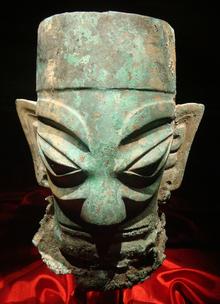
Bronze human head, 27cm high, Sanxingdui No. 1 sacrificial pit.
In the spring of 1929, the family of Yan Daocheng, a villager from Zhenwu Village, Nanxing Town, Guanghan County, found a rectangular pit surrounded by stone slabs while digging a water storage ditch next to their house, and the pit was filled with exquisite jade and stone artifacts. After Yan Daocheng with his family to the pit more than 400 pieces of jade moved home, hidden in various corners, and do not let the family tell people. A year later, in order to sell the jade, he sent a jade ring to Tao Zongbo, a brigade commander then stationed in Guanghan County, who, after learning the value of the jade ring, sent a company into the place where Yan Daocheng was digging for treasure, and excavated in the name of military training.
Gong Xitai, a famous jinshi scholar in Chengdu, purchased four jade pieces from the Yan family and wrote an article “Ancient Jade Examination” published in the inaugural issue of the school journal of the Chengdu Oriental Fine Arts College. Immediately afterwards, the news spread, antique dealers flocked to the area, and the excavation climaxed in the Guanghan area. The then governor of Guanghan County, Luo Yucang, believed that the antiquities should be owned by the state and immediately ordered that private digging should be banned.
On March 15, 1934, American Ge Weihan, director of the West China University Museum, and Professor Lin Mingjun, deputy director, formed an archaeological excavation team to excavate at Moon Bay, unveiling the prologue of archaeology in China’s western Sichuan plain. The first official excavation, which lasted more than ten days, unearthed a total of more than 600 artifacts.
In 1953, Feng Hanji, director of the Southwest Museum, and others reintroduced the possibility of an ancient cultural heritage in the area of Sanxingdui.
In 1956 Wang Jiayou and Jiang Dianchao of Sichuan Provincial Museum conducted archaeological investigations in the area of Sanxingdui-Yueyuewan.
In 1960, the archaeological research group of the Department of History of Sichuan University comprehensively investigated the cultural remains of Sanxingdui and Yuoyuowan and other places.
From 1970, brick factories were set up at the ancient sites of Sanxingdui and Yueliangwan, resulting in the destruction of large areas of ancient cultural sites.
In May 1980, the Sichuan Provincial Archaeological Team carried out rescue excavations at the site of Sanxingdui and found 18 house sites from the Longshan era and 3000-4000 years ago, 4 tombs, hundreds of pottery, stone and jade artifacts and tens of thousands of pottery specimens. 1982, the State Administration of Cultural Relics of China decided to earmark special funds for archaeological excavations at Sanxingdui.
In July 1986, the workers of the second brick factory in Nanxing Town, Guanghan County, broke a jade ring while digging the brick adobe soil, so the workers reported to the local archaeological team that this was the Sanxingdui No. 1 sacrificial pit. in August, the Sichuan Provincial Institute of Archaeology, led by the leader Chen De’an and the deputy leader Chen Xian Dan, conducted large-scale excavation work on Sanxingdui and found two large sacrificial pits of the same period as the Shang Dynasty, in which more than 1,700 pieces of bronze, jade, lacquer, pottery and pottery were unearthed. The pits unearthed more than 1,700 pieces of bronze, jade, lacquer, pottery, etc., as well as 80 ivory tusks and more than 4,600 pieces of currency, sea shells and copper shells of the time.
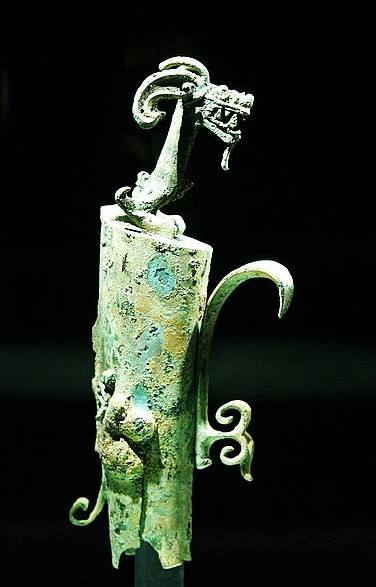
Sanxingdui Bronze Dragon Shaped Ornament
Since 1990, the exploration of the Sanxingdui culture and civilization has been extended from the Chengdu Plain to the Yudong area and the southern part of Shaanxi. Due to the initial revelation of the Neolithic cultural landscape of the Sichuan Basin, which predates the Sanxingdui culture, and the discovery of several ancient city sites of the Longshan era and several sites with the remains of the transition stage from the Neolithic culture to the Sanxingdui culture, it provides a broader prospect for the in-depth study of the Sanxingdui civilization.
In 1992, the foundation stone of Sanxingdui Museum was laid.
In May 1993, the relics of Sanxingdui were exhibited at the Olympic Museum in Lausanne, Switzerland. Although there was only one piece, it caused great repercussions in Switzerland and Europe. After that, European countries frequently invited the treasures of Sanxingdui to exhibit in Europe.
In 1997, the Sanxingdui Museum was opened, and its basic display won the top ten fine exhibitions of national museums in that year.
In 2002, the bronze sacred trees and jade side jangles of the excavated relics of Sanxingdui were included in the “first batch of banned cultural relics for exhibition abroad (in China) catalog” issued by the State Administration of Cultural Heritage.
From 2012 to 2015, the archaeology of Sanxingdui discovered large housing sites in Qingguan Mountain and important cultural remains of several sections of the wall, and the walls of the ancient city of Sanxingdui were enclosed.
In April 2019, Sichuan issued the “Implementation Opinions on Strengthening the Reform of the Protection and Utilization of Cultural Relics”, and the joint bid for the heritage of the Sanxingdui and Jinsha sites became the highlight.
Excavated cultural relics
Important cultural relics
National treasures: golden scepter, bronze standing figure, bronze sacred tree, bronze longitudinal eye mask, jade side jade, jade tooth jade.
Others: bronze beast mask, gold mask, bronze sun wheel, kneeling figure, bronze human body shaped ware, bronze large bird head.
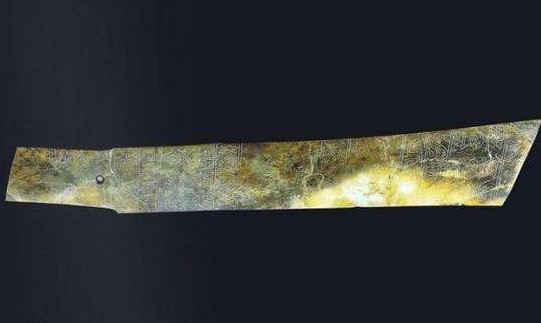
Sanxingdui jade side zhang excavated
Artifact characteristics
There are thousands of artifacts excavated from Sanxingdui sacrificial pit, including bronze, gold, jade and stone artifacts, among which the most characteristic is three to four hundred pieces of bronze.
1、Tall shape, vivid modeling, complex structure and profound connotation are the important characteristics of Sanxingdui bronzes.
2、Tri-star pile bronzes are characterized by a large number of figures, birds, animals, insects and snakes, and plants.
3、Most of the artifact types and shapes have extremely strong local characteristics.
Cultural Staging
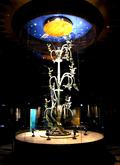
Bronze sacred tree
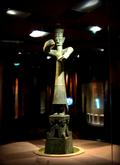
Bronze Standing Man Statue
The staging of Sanxingdui Culture can be divided into Sanxingdui Site Phase I, Phase II, Phase III and Phase IV according to its discovery at the time of archaeology. It can also be divided into Baodun culture, Sanxingdui culture and Twelve Bridges culture according to the cultural categories after the study. It has an important role in recognizing the relationship between Sanxingdui and the local pre-Qin period bronze culture and Neolithic culture, and also lays the foundation for perfecting the genealogy of the development of ancient culture in Sichuan and determining the formation of the civilization of Ba Shu. Its main excavation of hundreds of bronze pieces, as the bronze standing figure age in the fourth phase, generalized about 1200 BC-1000 BC, equivalent to the Central Plains region of Anyang Yinxu site.
During the first excavation of the Yuanyuanwan Zhenwu Palace site and the jade pit in 1933-1934, it was already noted that the two were of different ages. (layers 5 and 7), and the remaining five layers were called the “first to fifth cultural layers”. The fourth and fifth cultural layers (strata 6 and 8) are classified as the first phase, and the second and third cultural layers (strata 3 and 4) are classified as the second phase. In 1982, through the second excavation, the excavators suggested the existence of the fourth phase of the Sanxingdui site. At this point, the basic framework of Sanxingdui culture into four phases has been formed.
Sanxingdui Phase I Culture
The standard stratum was the 6th and 8th layers (the fourth and fifth cultural layers) of the first excavation, which basically corresponded to the lower layer (4th layer) of Xiquancan in 1984 and the lowermost layer (13th-16th layers) of the sixth excavation in 1986.
The earthenware quality of the excavated pottery is mainly clay gray earthenware, and about 65% of the excavated pottery is of this type of earthenware, including clay green gray earthenware and gray and white earthenware. The next is sandwich brown pottery, and there is also a small amount of uneven clay orange and yellow pottery. The shape of the ware is relatively monotonous, mainly flat ware, but also to a small number of ring-footed ware, most of them are difficult to recover. The decoration is mainly rope pattern, followed by scratch pattern, and the scratch pattern includes parallel line scratch pattern, water wave scratch pattern, geometric scratch pattern, and also in the parallel scratch pattern and then get the tooth shape. In addition there are a small number of cone piercing pattern and openwork decoration. One of the distinctive features of the pottery of this period is that the mouth of the vessel is pressed into a serrated lace.
This stratum has already appeared house construction, usually round or square in plan, using the method of digging post holes to set up post piles, connected with mud walls in the middle. Some of the houses are only 10-12 square meters in area, and it is presumed that they may be small houses of dry bar type.
The specimens collected in the sixth layer during the first excavation were identified by the Institute of Archaeology of the Chinese Academy of Social Sciences as being 4075±100 years old, 4500±150 years old after the tree wheel correction, and 2590-2340 B.C. after the high precision correction. Some other major data are 4170±85 years ago, 4210±80 years ago, etc. The overview is between about 2800 and 2000 B.C.E.
Sanxingdui II culture
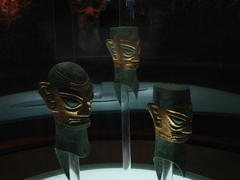
Gold Mask
The standard strata of Sanxingdui II culture are layers 3 and 4 (the second and third cultural layers) from the first excavation. Layers 11 and 12 of the sixth excavation are also typical strata. This stratum was present in all excavations, indicating that this phase I culture was widely distributed in the Sanxingdui site complex. Compared with the first phase of culture, the cultural landscape of this phase has changed considerably. It includes distinctive pottery and stone tools. It can be said that a typical group of artifacts representing the characteristics of the Sanxingdui culture has appeared. The difference with the third phase is mainly in the proportion of quantity and individual varieties.
The pottery quality changes to mainly sandwich brown pottery, followed by clay brown pottery. Ware shape is much richer than the first period, a new small flat-bottomed jar, high-handled beans, flat chassis, etc., also appeared a small number of bird’s head shape of the spoon handle. The decoration is mainly coarse rope pattern and fine rope pattern, with new convex string pattern, additional pile pattern, net pattern, etc. Stone tools include axes, adzes, chisels, mortars and pestles, and stone walls and stone spinning wheels are beginning to appear.
The plan of the single room of the house is usually rectangular or square, and some of them are connected into groups, and some of them have small ditches in the wall base, in which wooden piles are set up.
The date is about 3990±80 years ago, 4390±130 years after tree wheel correction, and 2471-2209 B.C. after high precision correction. Some other major data are 3525±170 years before present, etc. The overview is between about 1600 B.C.E. and 1300 B.C.E.
Important Remains
West City Wall
The West City Wall is located on a high plateau between the Duck River and the Mamu River in the northwest of the Sanxingdui site, running northeast-southwest, with a total length of about 600 meters, a top width of about 10-30 meters, a bottom width of about 35-50 meters, and a height of about 3-6 meters. There is a gap of about 20 meters wide in the middle and north of the wall, dividing the western wall into three sections: north, middle and south, of which the southern end of the middle section extends eastward at the gap for about 40 meters and is slightly vertical to the northern section of the middle section. According to the local test excavation combined with the analysis of the wall sections and the contents of the rammed earth exposed by the scouring of the Yazi River at the north end and the Mamu River at the south end, the structure, volume, ramming method and age of the west wall are similar to those of the south and east walls.
Moonlight Bay Wall
The Moon Bay Wall is located at the eastern edge of the Moon Bay Plateau in the north central part of the Sanxingdui site, and can be divided into two sections according to the direction, the north section is northeast-southwest direction, the south section is slightly folded to the east, basically in a positive north-south direction, and the whole wall is basically parallel to the north section of the West Wall. The total length of the surviving part of the wall is about 650 meters, with a top width of about 20 meters and a height of 2.4 to 5 meters. The bottom width at the north end is about 30 to 45 meters, and the middle section has an inflection with an angle of 148 degrees, the north end is 32 degrees, and the south end becomes orthogonal to the north-south direction. The southern section of the wall is higher and is leveled more by farming, with a width of 80 meters. There are trenches on the east (outer) side of the wall, and the width of the trenches ranges from 40 to 55 meters. At the excavated section, the trenches are 3.5 meters deep from the surface, and the trenches’ mouths are 2.95 meters deep from the bottom of the trenches.
Sacrificial pits
The famous sacrificial pits No. 1 and No. 2 are located more than 50 meters southeast of the wall of Sanxingdui, and the two pits are 25 meters apart, which is one of the most important archaeological discoveries of the site. The two pits have the same direction, both are northeast – southwest direction, the pit mouth is rectangular, large mouth and small bottom, the pit wall is neat, filled with soil by ramming.
Pit No. 1 is 4.5-4.64 meters long, 3.3-3.48 meters wide, and 1.46-1.64 meters deep, with a pit channel of about 1 meter wide and 0.34 (residual) to 3.85 meters long on each of the three sides of the pit opening, extending outward in a symmetrical layout. Pit No. 2 does not have a pit channel, and its entrance is 5.3 meters long, 2.2 to 2.3 meters wide, and 1.4 to 1.68 meters deep. Most of the artifacts were buried or buried before the intentional burning and destruction, or scorched, blackened, cracked, deformed, foamed or even melted, or mutilated, broken or even broken into several pieces (sections) and scattered in different locations in the pit, and some of the bronze artifacts, heads and masks have the phenomenon of vermilion painted on the mouth and black painted on the eyes. A total of 567 pieces of various artifacts were unearthed from pit 1, including 178 pieces of bronze, 4 pieces of gold, 129 pieces of jade, 70 pieces of stone, 13 pieces of ivory, 124 pieces of sea shells, 10 pieces of bone (carved with cloud and thunder patterns), 39 pieces of complete pottery and about 3 cubic meters of burnt bone fragments.
A total of 6095 pieces of various kinds of relics were unearthed from Pit No. 2 (together with fragments and remnants of identifiable individuals), including 736 pieces of bronze products, 61 pieces of gold products (pieces), 486 pieces of jade, 15 pieces of stone tools, 3 pieces of turquoise, 67 pieces of ivory, 120 pieces of ivory beads, 4 pieces of ivory ware, 3 pieces of tiger teeth, and 4600 pieces of sea shells.
The types of artifacts excavated from the two pits, except for some bronze vessels, jade and stone vessels common to the Xia and Shang periods in the Central Plains and pottery common to the sites of the Marsh culture, are mostly new artifacts that have never been found before, such as bronze group statues, bronze sacred tree groups, bronze sun-shaped vessels, bronze eye-shaped vessels, gold staffs, gold masks, etc. The artifacts excavated from the two pits are not only huge in quantity, rich in variety, complex, novel and mysterious in cultural appearance, but also peculiar in shape, extremely high in specification and exquisite in production, fully reflecting the highly developed bronze casting technology, gold smelting and processing technology, jade processing technology and unique aesthetic consciousness and religious beliefs of Shu in Shang Dynasty.
Rensheng Village Cemetery
The Rensheng Village Cemetery is located in the northwestern part of the site (outside the western wall), and is the first time that a public cemetery has been found in the site, and also the first time that important cultural relics have been found outside the ancient city. Only in the area of about 900 square meters, 29 small rectangular vertical cave mound and narrow vertical cave mound burials were excavated, with dense distribution and orderly arrangement of burials, basically the same direction, more elaborate processing of the chamber, most of the burials had a human skeleton, and the burial style was straight limb burial. A total of 17 burials unearthed jade, stone, pottery, ivory and other types of funerary objects, including jade and stone artifacts are mostly new artifacts found at the site for the first time, such as jade conical ware, jade tooth biscuit-shaped ware, jade bubble-shaped ware, obsidian beads, etc., of which jade tooth biscuit-shaped ware is extremely rare, jade conical ware is clearly with the style of Liangzhu culture in the lower reaches of the Yangtze River, attracting attention. There is another jade toothpick-shaped vessel with nine round holes drilled on its surface, which may be related to ancient divination. Scholars believe that the burial dates of these 29 tombs are basically the same, corresponding to the Xia Dynasty period in the Central Plains. The discovery of Rensheng Village Cemetery is of great value to further clarify the layout of the ancient city of Sanxingdui, to understand the funerary customs and divination rituals of the Sanxingdui culture, and to link it with the archaeological culture of other regions.
Qing Guanshan Site
The Qing Guanshan site is located on a terrace on the south bank of the Yuzi River. After archaeological excavation, a large red-burned earth house site was found. The site is presumed to be rectangular in plan, with a northwest-southeast orientation, and the area that can be observed now is about 100 square meters.
The residual length of the northwest-southeast column is 50 meters and the width is 14 meters. The room base is 0.35 to 1.5 meters wide, all of which are red-burned earth rammed and interspersed with a large number of pebbles. The base groove is 3 to 4.5 meters wide. It is presumed that the construction method is to dig the foundation groove first, and then ram the foundation of the house. On both sides (0.5-1 m from the edge of the house base), rows of eaves columns – red-burned clay blocks were found on both sides of the house base. The red-burned earth blocks are generally rectangular, ranging from 0.45 to 0.6 meters in length and 0.25 to 0.35 meters in width. Between the two rows of gables there may have been a corridor.
Due to the limited excavation area and the lack of anatomy, the actual area, construction method, residual height and depth of the house site are still unclear, pending further archaeological excavation. However, a house site of this scale has never been encountered in the site of Sanxingdui, and its function has far exceeded the need for a general living room. It is assumed that it was most likely a palace building, dating from the Shang Dynasty.
Sanxingdui Museum
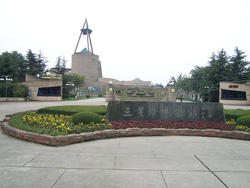
Sanxingdui Museum
The Sanxingdui Museum is located in the northeastern part of the Sanxingdui site and was opened in October 1997 to fully display Sanxingdui artifacts. 2000, the Sanxingdui Museum was rated as a national AAAA tourist attraction.
The Sanxingdui Museum includes the No.1 exhibition hall and the No.2 exhibition hall. The second exhibition hall includes four parts: the preface exhibition hall, the country of the gods (display of various bronze masks), the soul of Shu in a thousand years (display of the essence of the relics of Sanxingdui), and the eternal glory of Sanxingdui (chronicle of events and the mystery of Sanxingdui).
Historic Value
The discovery of the Sanxingdui site is important to historiography in the following ways.
It gives a new understanding of the Ba Shu culture. The discovery of the Sanxingdui site is very different from the long-standing historical understanding of the culture of Ba Shu, and in some places it is even completely different. For example, the historical community has always believed that compared to the Central Plains, the ancient Ba Shu region was a relatively closed place with no or little interaction with the Central Plains civilization. The site of Sanxingdui, on the other hand, proves that it should have been an important cultural center in China around the Xia-Shang period, or even earlier, and had some connection with the culture of the Central Plains.
It verifies the authenticity of the ancient literature on the ancient Shu Kingdom.
According to scholar Ju Deyuan, the ancient Shu kingdom of Sanxingdui civilization is the most original birthplace of the typical records and physical remains of the inherited reproduction of the Chinese Xia ritual system (including the worship of the silkworm gods, groveling mulberry, national exorcism ceremony, funeral rituals, ritual vessels, scepters, jade scepters, etc.).
Inheritance application work
In May 2017, the Chengdu Municipal Bureau of Culture, Radio, Film and Television reported for finalization the “Implementation Opinions on Further Strengthening Cultural Relics (Draft for Review)” revealed that the Jinsha Site and the Sanxingdui Site were jointly declared a World Cultural Heritage Site. If the Jinsha Site and Sanxingdui joint declaration of world cultural heritage is successful, this will be the first in Sichuan archaeological heritage category of world cultural heritage.
For the inscription work, at present the three stars pile is in an orderly manner, has entered the State Administration of Cultural Heritage to declare the world cultural heritage in the preparatory list. The “inscription” work has a long process, Jinsha and Sanxingdui were originally world-class cultural heritage, the successful inscription will be recognized and respected by the industry, but also can better inherit and protect the Chinese civilization, especially the ancient Shu civilization.
Film and television culture
Since 2016 the official investment in the animation film of the Three Stars Pile, The Golden Mask (English title: TheGoldenMask), which uses 3D digital technology, IMAX standard, targeting the international market, is expected to achieve a global release in 2019.
In October 2016 Arnold Schwarzenegger became China’s global ambassador for the culture of the Three Star Piles, and another science fiction film with the theme of the Three Star Piles is in the pipeline.